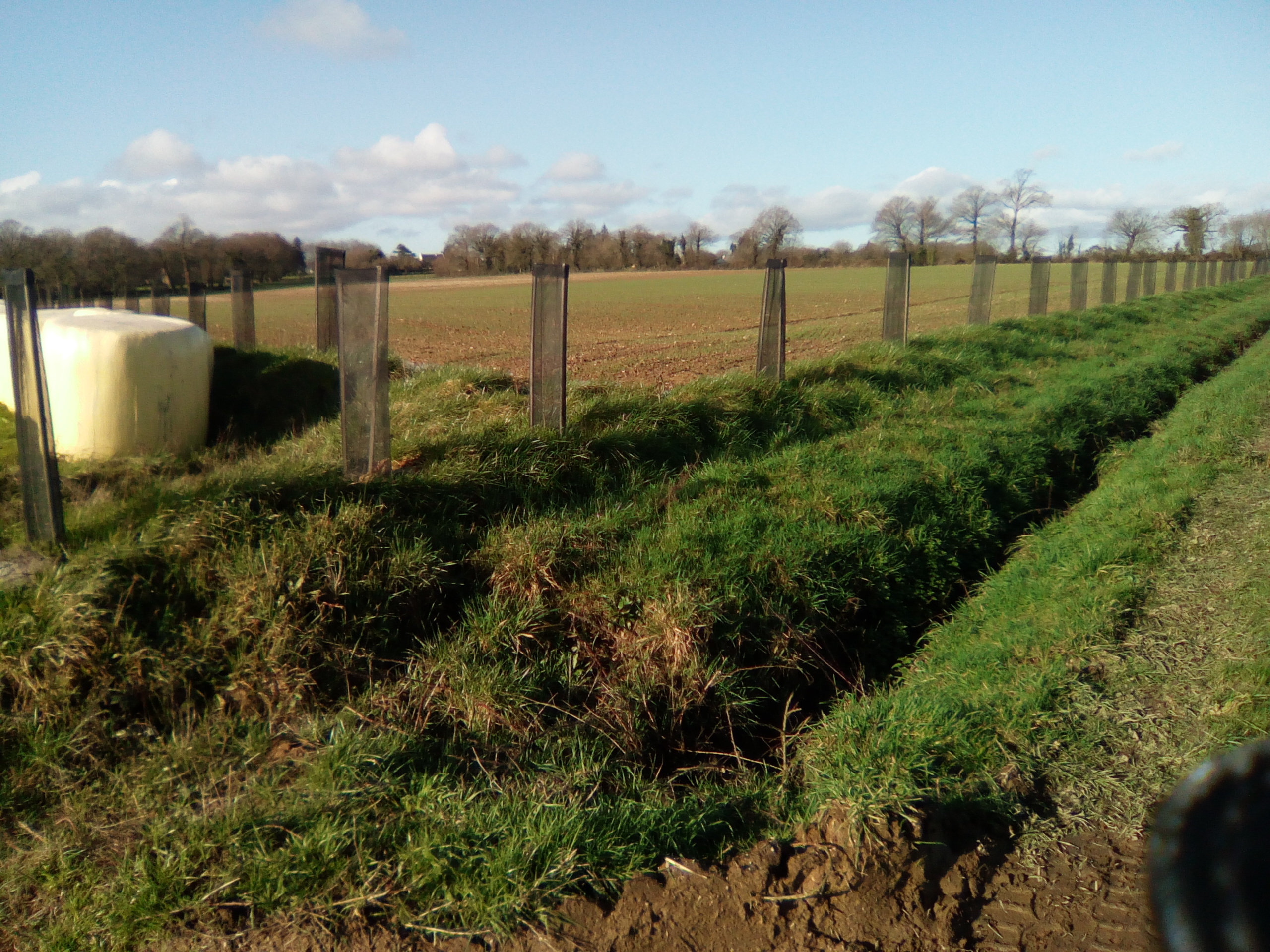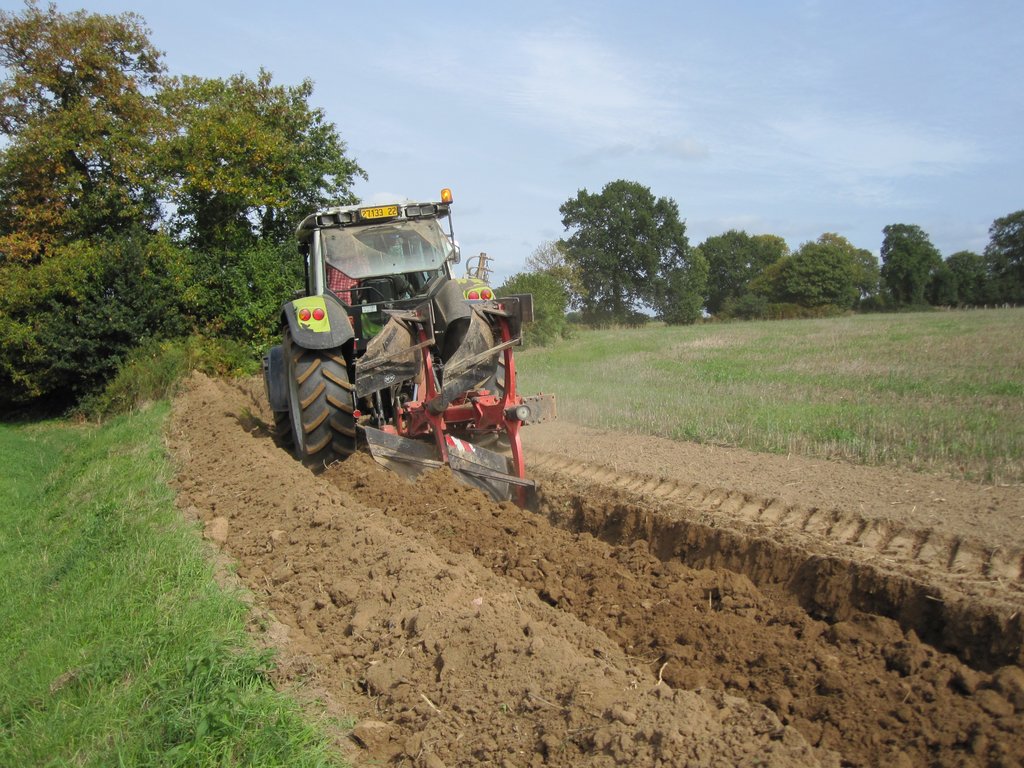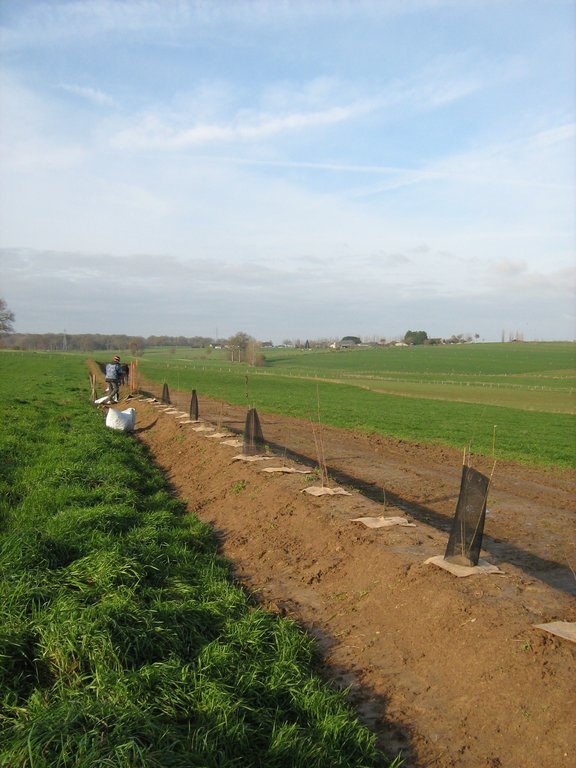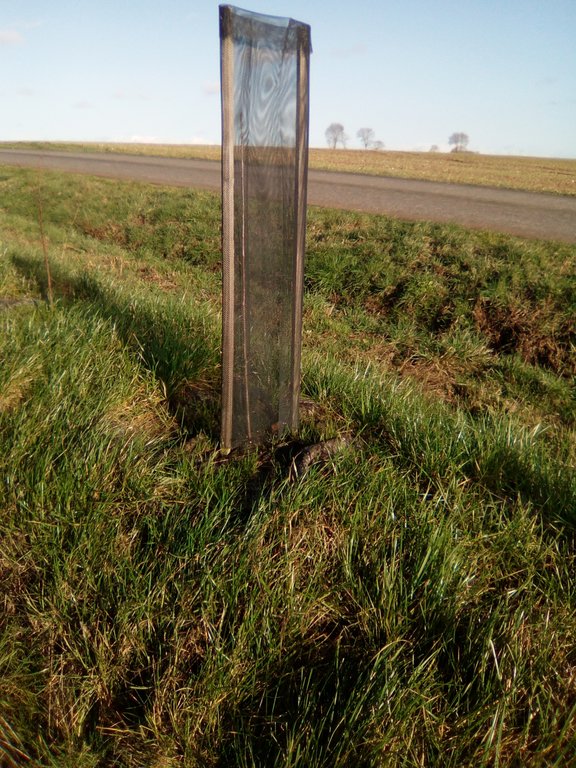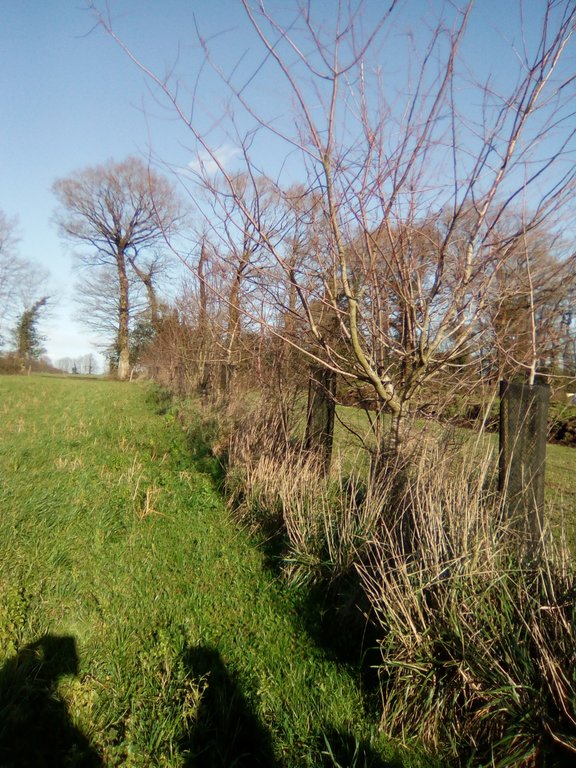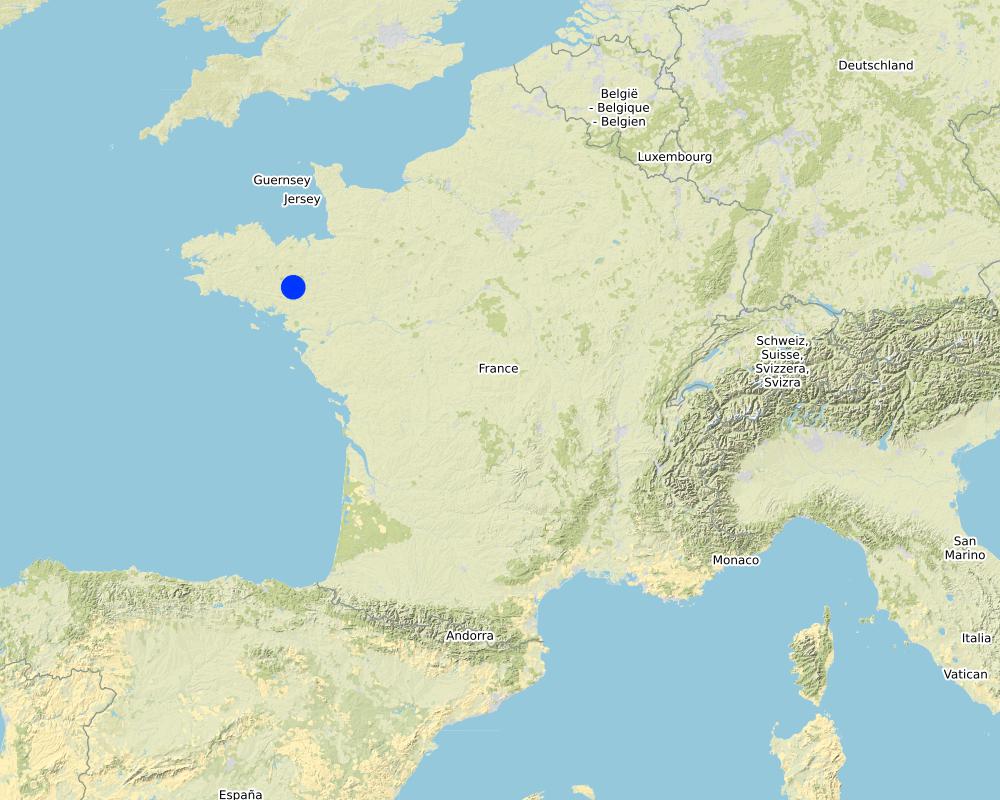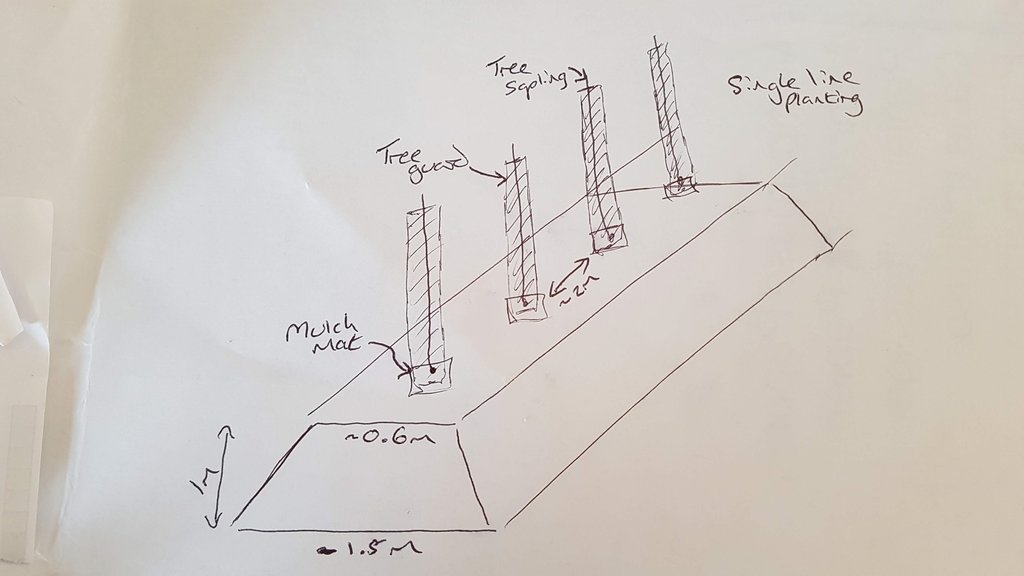Hedgerow establishment on an agro-pastoral farm for dairy cows [France]
- Création :
- Mise à jour :
- Compilateur : Alan Radbourne
- Rédacteurs : David Robinson, David Norris, Sabine Reinsch
- Examinateur : Rima Mekdaschi Studer
Bocage
technologies_5681 - France
Voir les sections
Développer tout Réduire tout1. Informations générales
1.2 Coordonnées des personnes-ressources et des institutions impliquées dans l'évaluation et la documentation de la Technologie
Personne(s)-ressource(s) clé(s)
co-compiler:
Joubioux Christiane
Chambre Regionale D'Agriculture De Bretagne, Regional Chamber of Agriculture of Brittany
France
exploitant des terres:
Danilo Noël
Danilo Noel
France
Spécialiste GDT:
Senegas Isabelle
Chambre Regionale D'Agriculture De Bretagne, Regional Chamber of Agriculture of Brittany
France
Nom du projet qui a facilité la documentation/ l'évaluation de la Technologie (si pertinent)
European Interreg project FABulous FarmersNom du ou des institutions qui ont facilité la documentation/ l'évaluation de la Technologie (si pertinent)
UK Centre for Ecology & Hydrology (CEH) - Royaume-UniNom du ou des institutions qui ont facilité la documentation/ l'évaluation de la Technologie (si pertinent)
Association des Chambres d’agriculture de l’Arc Atlantique (AC3A) - France1.3 Conditions relatives à l'utilisation par WOCAT des données documentées
Le compilateur et la(les) personne(s) ressource(s) acceptent les conditions relatives à l'utilisation par WOCAT des données documentées:
Oui
1.4 Déclaration sur la durabilité de la Technologie décrite
Est-ce que la Technologie décrite ici pose problème par rapport à la dégradation des terres, de telle sorte qu'elle ne peut pas être déclarée comme étant une technologie de gestion durable des terres?
Non
2. Description de la Technologie de GDT
2.1 Courte description de la Technologie
Définition de la Technologie:
Low-maintenance hedgerows were established in 2003 at the ridges of an agro-pastoral farm common in Brittany to protect water quality, ensure animal well-being, maintain biodiversity, and for energy, timber and litter production.
2.2 Description détaillée de la Technologie
Description:
Brittany is an area in the north-west of France. Brittany’s agriculture includes well-known products such as: fish, beef, pork, poultry, vegetables and milk. The technology is applied at Danilo Noël farm, located in the commune of Mauron in Morbihan. The region has an average annual rainfall of 650-700 mm and annual temperature of around 11°C. The climate of Mauron is warm and temperate, with the farm located in the basin known as Ploërmel. ‘Bocages’ in France refer to small forests and decorative elements such as hedgerows or ornamental garden structures that border agricultural fields .
The fields of the Danilo Noël farm are grouped together in a rotational system of fodder crop and short-term pastoral leys, divided into fenced paddocks. They are located between two ‘talwegs’, with slopes of 5 or 6 %. An analysis carried out in 2000 by the water management organization ‘Grand Bassin de l'Oust’, shows that 85% of the plots are at high and medium risk of plant protection product runoff due to the slope and water run-off.
Following this evaluation of the farm, the ‘Bocage’ (small hedged pasturelands) was developed starting during the winter of 2003/2004, with the planting of 800 meters of woody features (hedges and trees) along the slopes of the talweg. Other slope plantings were carried out on the edge of the paddock in 2014/2015 (1500 meters) and 2018/2019 (1650 meters).
Earth bunds were established along the contour, either with a shovel (in 2003 and 2014) or with a forest plough (in November 2018), with hedge and tree whips (1-2 year old growth) planted 1 meter apart in single rows diectly into the shovel or plough furrow and a small amount of fertiliser and wire tree guards added. There was no irregation installed.
The technology was applied in three differnt phases combining to form one overall long-term plan. The tree species chosen for the hedgerow are local species (oak, beech, cherry, birch, myrobolan plum, chestnut, hazelnut, etc.). For the last two phases of the programs (2014 & 2018), emphasis was placed on the presence of melliferous species (for honey production) and the spread of flowering species (fruit trees, burdock, blood dogwood, medlar, etc.).
Buffering of fields with hedgerows aims to protect surface water quality and prevent land degradation by slowing surface water runoff and hence reducing soil erosion, nutrient and plant-protection product (pesticide) export and improving water infiltration into the soil and groundwater recharge. The reduction of soil erosion in turn improves productivity with a better surface cover and nutrient retention for improved plant establishment and growth. Additionally, maintenance and/or improvement of biodiverstiy can be attained as well as providing shelter for animals supports their well-being.
Major activities of the technology include: Tipping of trees (old and new) in spring/summer, soil preparation at the site of the future hedge in autumn and creation of the embankment (earth bund along the contour), tree planting over winter and laying of mulch and installation of game guards.
Benefits of the hedgerows/ shelter belts are reorganization and improvement of the field to reduce flooding, protect water quality , improve welfare of the livestock, Increase biodiversity of wildlife, including insects, birds and game. Additional honey bee forage supported the installation of an apiary (18 colonies) by a professional beekeeper in May 2019.
The only weakness of the technology in the eyes of the land owner was the extra cost/workload associated with the maintenance of the hedgerows.
The compilation of this SLM is a part of the European Interreg project FABulous Farmers which aims to reduce the reliance on external inputs by encouraging the use of methods and interventions that increase the farm’s Functional AgroBiodiversity (FAB). Visit www.fabulousfarmers.eu and www.nweurope.eu/Fabulous-Farmers for more information.
2.3 Photos de la Technologie
2.5 Pays/ région/ lieux où la Technologie a été appliquée et qui sont couverts par cette évaluation
Pays:
France
Région/ Etat/ Province:
Brittany
Spécifiez la diffusion de la Technologie:
- répartie uniformément sur une zone
S'il n'existe pas d'informations exactes sur la superficie, indiquez les limites approximatives de la zone couverte:
- 0,1-1 km2
Est-ce que les sites dans lesquels la Technologie est appliquée sont situés dans des zones protégées en permanence?
Non
Map
×2.6 Date de mise en œuvre de la Technologie
Indiquez l'année de mise en œuvre:
2003
2.7 Introduction de la Technologie
Spécifiez comment la Technologie a été introduite: :
- grâce à l'innovation d'exploitants des terres
- par le biais de projets/ d'interventions extérieures
Commentaires (type de projet, etc.) :
The farmer since 2000 has implemented various measures aimed at sustainable agriculture on the farm, and more recently (since 2018) the farm has become a 'pilot farm' in what is now the FABulous Farmers project aiming to improve biodiversity by enhancing the production system.
3. Classification de la Technologie de GDT
3.1 Principal(aux) objectif(s) de la Technologie
- améliorer la production
- conserver/ améliorer la biodiversité
- s'adapter au changement et aux extrêmes climatiques et à leurs impacts
3.2 Type(s) actuel(s) d'utilisation des terres, là où la Technologie est appliquée
Les divers types d'utilisation des terres au sein du même unité de terrain: :
Oui
Précisez l'utilisation mixte des terres (cultures/ pâturages/ arbres):
- Agropastoralisme (y compris les systèmes culture-élevage intégrés)

Terres cultivées
- Cultures annuelles
- Hedge plantation
- wheat, corn
Nombre de période de croissance par an: :
- 1
Est-ce que les cultures intercalaires sont pratiquées?
Non
Est-ce que la rotation des cultures est appliquée?
Oui
Si oui, veuillez préciser:
Rotation of 1 year wheat, 1 year corn, 1 year fallow.

Pâturages
Pâturage intensif/ production fourragère :
- Prairies améliorées
Type d'animal:
- bétail - laitier
Est-ce que la gestion intégrée cultures-élevage est pratiquée?
Oui
Si oui, veuillez préciser:
Manure intentionally used to improve crop production & crop residues are fed to animals.
Produits et services:
- lait
- grassland, corn silage, wheat
Espèces:
bétail - laitier
Nombre:
62
Commentaires:
The hedges are planted on the periphery of the plot on embankments without interfering with the original land use.
3.3 Est-ce que l’utilisation des terres a changé en raison de la mise en œuvre de la Technologie ?
Est-ce que l’utilisation des terres a changé en raison de la mise en œuvre de la Technologie ?
- Non (Passez à la question 3.4)
Les divers types d'utilisation des terres au sein du même unité de terrain: :
Non
3.4 Approvisionnement en eau
Approvisionnement en eau des terres sur lesquelles est appliquée la Technologie:
- pluvial
3.5 Groupe de GDT auquel appartient la Technologie
- agroforesterie
- brise-vent/ plantations abris
- gestion intégrée cultures-élevage
3.6 Mesures de GDT constituant la Technologie

pratiques végétales
- V1: Couverture d’arbres et d’arbustes

structures physiques
- S2: Diguettes, digues
- S9: Abris pour plantes et animaux
3.7 Principaux types de dégradation des terres traités par la Technologie

érosion hydrique des sols
- Wt: perte de la couche superficielle des sols (couche arable)/ érosion de surface
- Wo: effets hors-site de la dégradation

dégradation biologique
- Bh: perte d’habitats

dégradation hydrique
- Hs: changement de la quantité d’eau de surface
- Hp: baisse de la qualité des eaux de surface
3.8 Prévention, réduction de la dégradation ou réhabilitation des terres dégradées
Spécifiez l'objectif de la Technologie au regard de la dégradation des terres:
- prévenir la dégradation des terres
4. Spécifications techniques, activités, intrants et coûts de mise en œuvre
4.1 Dessin technique de la Technologie
Spécifications techniques (associées au dessin technique):
Creation of the embankment
- Use of the backhoe or excavator (2003/2004 and 2014/2015 developments)
- Earth removed from the field over a few metres wide - implementation by vertical compaction as the slope rises - shaping of the sides by slicing.
- Use of the forestry plough (2018/2019 development)
- 5 to 7 passes of the forestry plough to lift a 0.6 to 0.8 cm high ridge - bucket finishing for levelling .
Planting
- Choose deciduous species adapted to the environmental conditions (soil, climate) and combine several species in a hedge.
- For a honey hedge (source of pollen and nectar for bees), aim to spread out the flowering with species accessible to bees (hazelnut, burdock, black elder, blood dogwood, obier viorne, country maple, small-leaved linden, cherry, chestnut, black alder, willow...).
- Install biodegradable mulch at the foot of each plant and protection against wildlife (deer, hare, rabbit).
Auteur:
Isabelle Senegas
Date:
03/02/2020
Spécifications techniques (associées au dessin technique):
Example section of planting on embankment. Single line planting of tree saplings on top of embankment, mulch mat around foot of plant, tree guard installed.
Auteur:
Alan Radbourne
Date:
12/02/2021
4.2 Informations générales sur le calcul des intrants et des coûts
Spécifiez la manière dont les coûts et les intrants ont été calculés:
- par entité de la Technologie
Précisez l'unité:
meter
Précisez les dimensions de l'unité de terrain (le cas échéant):
1650
autre/ monnaie nationale (précisez):
€
Indiquez le taux de change des USD en devise locale, le cas échéant (p.ex. 1 USD = 79.9 réal brésilien): 1 USD = :
0,9
Indiquez le coût salarial moyen de la main d'œuvre par jour:
€10.15 on 1 January 2020, i.e. €1,539.42 monthly on the basis of the legal working week of 35 hours.
4.3 Activités de mise en place/ d'établissement
| Activité | Calendrier des activités (saisonnier) | |
|---|---|---|
| 1. | Tip saplings to form seedling transplants for new plants | spring-summer year 0 |
| 2. | Soil preparation at the site of the future hedge | September to October year 0 |
| 3. | Creation of the embankment using excavator or forestry plough to establish soil bunds. Vertical compaction of slopes and shaping. | September to October year 0 |
| 4. | Tree planting using several deciduous species adapted to the envionmental conditions. | December to March (year 0-1) |
| 5. | Laying of biodegradable mulch at the foot of each plant to provide nutrients and moisture retention | December to March (year 0-1) |
| 6. | Installation of game guards to protect againt wildlife (deer, hare, rabbit). | December to March (year 0-1) |
| 7. | Creation of grass strips at the foot of the slope to stabilise embankment | December to March (year 0-1) |
4.4 Coûts et intrants nécessaires à la mise en place
| Spécifiez les intrants | Unité | Quantité | Coûts par unité | Coût total par intrant | % des coût supporté par les exploitants des terres | |
|---|---|---|---|---|---|---|
| Main d'œuvre | Tip saplings | metre | 1650,0 | 0,35 | 577,5 | |
| Main d'œuvre | Soil preparation | metre | 1650,0 | 0,8 | 1320,0 | |
| Main d'œuvre | Creation of the embankment & grass strips | metre | 1650,0 | 1,8 | 2970,0 | |
| Main d'œuvre | Tree planting, mulching & protection | metre | 1650,0 | 2,0 | 3300,0 | |
| Equipements | Excavator / Forest plough | metre | 1650,0 | 0,5 | 825,0 | |
| Equipements | Biodegradable mulch | metre | 1650,0 | 0,3 | 495,0 | |
| Equipements | Tree guards | metre | 1650,0 | 0,7 | 1155,0 | |
| Coût total de mise en place de la Technologie | 10642,5 | |||||
| Coût total de mise en place de la Technologie en dollars américains (USD) | 11825,0 | |||||
Commentaires:
The bocage development programme is carried out by the Great Oust basin with the following financial partners: Europe, the Loire-Brittany Water Agency, the Brittany Region, the Morbihan Department. The operator will have to pay €1 (excluding tax) per linear metre.
4.5 Activités d'entretien/ récurrentes
| Activité | Calendrier/ fréquence | |
|---|---|---|
| 1. | Hedge pruning and training | Winters for 10-15 years |
| 2. | Lateral pruning of the flower part of the hedges | as required between two wood harvests (with a chainsaw) |
| 3. | Slope maintenance (brush clearing and grazing) | once a year |
| 4. | Wood harvest: re-growing of out-sticking branches (Coppice and shrubs) | 15 years after planting, then every 10-15 years |
4.6 Coûts et intrants nécessaires aux activités d'entretien/ récurrentes (par an)
| Spécifiez les intrants | Unité | Quantité | Coûts par unité | Coût total par intrant | % des coût supporté par les exploitants des terres | |
|---|---|---|---|---|---|---|
| Main d'œuvre | Hedge pruning and training | meter | 1650,0 | 0,25 | 412,5 | 100,0 |
| Equipements | Mechanical intervention: annual clearing | meter | 1650,0 | 0,35 | 577,5 | 100,0 |
| Matériaux de construction | Thermal brushcutter for landscaping and forestry work (investment to be amortized) | meter | 1650,0 | 0,6 | 990,0 | 100,0 |
| Autre | Maintenance of the embankment | meter | 1650,0 | 0,15 | 247,5 | 100,0 |
| Autre | od storage, chipping, transport of chips | meter | 1650,0 | 0,25 | 412,5 | 100,0 |
| Coût total d'entretien de la Technologie | 2640,0 | |||||
| Coût total d'entretien de la Technologie en dollars américains (USD) | 2933,33 | |||||
4.7 Facteurs les plus importants affectant les coûts
Décrivez les facteurs les plus importants affectant les coûts :
- consistency of management
- hedge width
- Existence of outlets for wood (self-consumption, local industries, etc.)
5. Environnement naturel et humain
5.1 Climat
Précipitations annuelles
- < 250 mm
- 251-500 mm
- 501-750 mm
- 751-1000 mm
- 1001-1500 mm
- 1501-2000 mm
- 2001-3000 mm
- 3001-4000 mm
- > 4000 mm
Spécifiez la pluviométrie moyenne annuelle (si connue), en mm:
700,00
Spécifications/ commentaires sur les précipitations:
The farm is situated in the commune of Ploërmel in the Morbihan which lies in the early pedoclimatic zone.
The average annual rainfall is between 650-750 mm over the period 1971-2000.
The average annual temperature is around 11.5°C over the period 1971-2000.
Indiquez le nom de la station météorologique de référence considérée:
Ploermel
Zone agro-climatique
- subhumide
The Ploërmel basin is the most continental of the Morbihan with colder winters, warmer summers and rainfall between 650 and 750 mm/year.
5.2 Topographie
Pentes moyennes:
- plat (0-2 %)
- faible (3-5%)
- modéré (6-10%)
- onduleux (11-15%)
- vallonné (16-30%)
- raide (31-60%)
- très raide (>60%)
Reliefs:
- plateaux/ plaines
- crêtes
- flancs/ pentes de montagne
- flancs/ pentes de colline
- piémonts/ glacis (bas de pente)
- fonds de vallée/bas-fonds
Zones altitudinales:
- 0-100 m
- 101-500 m
- 501-1000 m
- 1001-1500 m
- 1501-2000 m
- 2001-2500 m
- 2501-3000 m
- 3001-4000 m
- > 4000 m
Indiquez si la Technologie est spécifiquement appliquée dans des:
- non pertinent
Commentaires et précisions supplémentaires sur la topographie:
The farm is located between two talwegs. Altitudes vary between 75 and 100 m. The steepest slopes (on the southern slope) are about 6%.
5.3 Sols
Profondeur moyenne du sol:
- très superficiel (0-20 cm)
- superficiel (21-50 cm)
- modérément profond (51-80 cm)
- profond (81-120 cm)
- très profond (>120 cm)
Texture du sol (de la couche arable):
- moyen (limoneux)
Texture du sol (> 20 cm sous la surface):
- grossier/ léger (sablonneux)
Matière organique de la couche arable:
- faible (<1%)
Si disponible, joignez une description complète du sol ou précisez les informations disponibles, par ex., type de sol, pH/ acidité du sol, capacité d'échange cationique, azote, salinité, etc.
The farm is located in the commune of Ploërmel in Morbihan is in the geological zone of the Briovian Shale:
- Soil mapping unit (UCS (soil map units) n°4034): Brown soils gradually leached from the plains and plateaux from locally sandstone soft shale (including deep valley bottom soils, hydromorphic from the surface, with colluvio-alluvial or alluvial input).
- Soil mapping unit (UCS (soil map units) n°4040): Mainly well-drained and poorly leached soils of cultivated plateaus from soft shale.
Source Sols de Bretagne (http://www.sols-de-bretagne.fr/)
5.4 Disponibilité et qualité de l'eau
Profondeur estimée de l’eau dans le sol:
5-50 m
Disponibilité de l’eau de surface:
bonne
Qualité de l’eau (non traitée):
faiblement potable (traitement nécessaire)
La qualité de l'eau fait référence à:
à la fois les eaux souterraines et de surface
La salinité de l'eau est-elle un problème? :
Non
La zone est-elle inondée?
Non
5.5 Biodiversité
Diversité des espèces:
- élevé
Diversité des habitats:
- moyenne
Commentaires et précisions supplémentaires sur la biodiversité:
Medium habitat diversity due to still young age of the hedges)
5.6 Caractéristiques des exploitants des terres appliquant la Technologie
Sédentaire ou nomade:
- Sédentaire
Orientation du système de production:
- commercial/ de marché
Revenus hors exploitation:
- moins de 10% de tous les revenus
Niveau relatif de richesse:
- moyen
Individus ou groupes:
- individu/ ménage
Niveau de mécanisation:
- mécanisé/ motorisé
Genre:
- hommes
Age des exploitants des terres:
- personnes d'âge moyen
5.7 Superficie moyenne des terres utilisées par les exploitants des terres appliquant la Technologie
- < 0,5 ha
- 0,5-1 ha
- 1-2 ha
- 2-5 ha
- 5-15 ha
- 15-50 ha
- 50-100 ha
- 100-500 ha
- 500-1 000 ha
- 1 000-10 000 ha
- > 10 000 ha
Cette superficie est-elle considérée comme de petite, moyenne ou grande dimension (en se référant au contexte local)?
- moyenne dimension
Commentaires:
The farm covers an area of 66 ha, 60 ha of which are accessible for grazing and some of which are wet.
5.8 Propriété foncière, droits d’utilisation des terres et de l'eau
Propriété foncière:
- individu, avec titre de propriété
Droits d’utilisation des terres:
- loué
Droits d’utilisation de l’eau:
- accès libre (non organisé)
Est-ce que les droits d'utilisation des terres sont fondés sur un système juridique traditionnel?
Non
5.9 Accès aux services et aux infrastructures
santé:
- pauvre
- modéré
- bonne
éducation:
- pauvre
- modéré
- bonne
assistance technique:
- pauvre
- modéré
- bonne
emploi (par ex. hors exploitation):
- pauvre
- modéré
- bonne
marchés:
- pauvre
- modéré
- bonne
énergie:
- pauvre
- modéré
- bonne
routes et transports:
- pauvre
- modéré
- bonne
eau potable et assainissement:
- pauvre
- modéré
- bonne
services financiers:
- pauvre
- modéré
- bonne
6. Impacts et conclusions
6.1 Impacts sur site que la Technologie a montrés
Impacts socio-économiques
Production
production agricole
Commentaires/ spécifiez:
diversification of production
qualité des cultures
Commentaires/ spécifiez:
remained same
production fourragère
Commentaires/ spécifiez:
Shelter belts protection of crops
qualité des fourrages
Commentaires/ spécifiez:
remained same
production animale
Commentaires/ spécifiez:
Well-being improves production
production de bois
Commentaires/ spécifiez:
New output product on land
diversité des produits
Commentaires/ spécifiez:
Wood produced
gestion des terres
Commentaires/ spécifiez:
Increased labour but more sustainable water and land management
Revenus et coûts
dépenses pour les intrants agricoles
Commentaires/ spécifiez:
New machinery and labour costs associated with diversified management
revenus agricoles
Commentaires/ spécifiez:
Increased output production
diversité des sources de revenus
Commentaires/ spécifiez:
Addition of woody crop output
charge de travail
Commentaires/ spécifiez:
Increased workload with hedgerow management
Impacts socioculturels
droits d'utilisation des terres/ de l'eau
possibilités de loisirs
Commentaires/ spécifiez:
quality of life
connaissances sur la GDT/ dégradation des terres
Impacts écologiques
Cycle de l'eau/ ruissellement
qualité de l'eau
Commentaires/ spécifiez:
Improved water quality in streams due to reduced surface run-off with hedgerow buffer strips
ruissellement de surface
Commentaires/ spécifiez:
Decreased run-off with hedgerow buffering
drainage de l'excès d'eau
Commentaires/ spécifiez:
Rooting system reducing flooding
Sols
perte en sol
Commentaires/ spécifiez:
Reduced soil erosion from buffered strips
matière organique du sol/ au dessous du sol C
Commentaires/ spécifiez:
Hedgerow inceasing below ground C
Biodiversité: végétale, animale
Couverture végétale
Commentaires/ spécifiez:
longer cover of vegetation with hedgerows
biomasse/ au dessus du sol C
Commentaires/ spécifiez:
hedgerows increase above ground C
diversité végétale
Commentaires/ spécifiez:
Woody crops added
diversité animale
Commentaires/ spécifiez:
Biodiversity increases with hedgerow habitat creation
espèces bénéfiques
Commentaires/ spécifiez:
Bees, insects and birds as predators of pests
diversité des habitats
Commentaires/ spécifiez:
Habitat creation in hedgerows
contrôle des animaux nuisibles/ maladies
Commentaires/ spécifiez:
cultivation aids
Réduction des risques de catastrophe et des risques climatiques
impacts des inondations
Commentaires/ spécifiez:
Buffer strips & rooting systems improving infiltration
glissements de terrains/coulées de débris
Commentaires/ spécifiez:
Buffer strips slowing suface water flow and soil erosion
impacts de la sécheresse
Commentaires/ spécifiez:
Buffer strips limit water loss in drought
vitesse du vent
Commentaires/ spécifiez:
buffer strips provide crop and animal shelter
6.2 Impacts hors site que la Technologie a montrés
inondations en aval
Commentaires/ spécifiez:
regulation of belt slope eriosion
pollution des rivières/ nappes phréatiques
Commentaires/ spécifiez:
Reduced soil, nutrient and plant protection run-off polluting watercourses
capacité tampon/de filtration
Commentaires/ spécifiez:
hedges slow flow as a buffer
sédiments (indésirables) transportés par le vent
Commentaires/ spécifiez:
shelter and sedimant capture
impact des gaz à effet de serre
Commentaires/ spécifiez:
Intake from hedges
6.3 Exposition et sensibilité de la Technologie aux changements progressifs et aux évènements extrêmes/catastrophes liés au climat (telles que perçues par les exploitants des terres)
Changements climatiques progressifs
Changements climatiques progressifs
| Saison | Augmentation ou diminution | Comment la Technologie fait-elle face à cela? | |
|---|---|---|---|
| températures annuelles | augmente | bien | |
| précipitations annuelles | décroît | bien |
Extrêmes climatiques (catastrophes)
Catastrophes météorologiques
| Comment la Technologie fait-elle face à cela? | |
|---|---|
| pluie torrentielle locale | très bien |
Catastrophes climatiques
| Comment la Technologie fait-elle face à cela? | |
|---|---|
| canicule | bien |
| vague de froid | modérément |
| sécheresse | modérément |
Catastrophes hydrologiques
| Comment la Technologie fait-elle face à cela? | |
|---|---|
| inondation générale (rivière) | bien |
| glissement de terrain | modérément |
Autres conséquences liées au climat
Autres conséquences liées au climat
| Comment la Technologie fait-elle face à cela? | |
|---|---|
| prolongement de la période de croissance | pas connu |
| réduction de la période de croissance | pas connu |
| élévation du niveau de la mer | modérément |
6.4 Analyse coûts-bénéfices
Quels sont les bénéfices comparativement aux coûts de mise en place (du point de vue des exploitants des terres)?
Rentabilité à court terme:
légèrement négative
Rentabilité à long terme:
légèrement positive
Quels sont les bénéfices comparativement aux coûts d'entretien récurrents (du point de vue des exploitants des terres)?
Rentabilité à court terme:
légèrement négative
Rentabilité à long terme:
positive
6.5 Adoption de la Technologie
- 1-10%
De tous ceux qui ont adopté la Technologie, combien d'entre eux l'ont fait spontanément, à savoir sans recevoir aucune incitation matérielle, ou aucune rémunération? :
- 0-10%
Commentaires:
Several Breton regional programmes that aimed at improving water quality have made it possible to support bocage developments thanks to the involvement of financial partners from 2008 to 2020, as part of the wider "Breizh Bocage" programme. The remaining amount to be paid by the operator is 1€ per linear meter in the current programme.
6.6 Adaptation
La Technologie a-t-elle été récemment modifiée pour s'adapter à l'évolution des conditions?
Oui
autre (précisez):
economic concern of operating system
Spécifiez l'adaptation de la Technologie (conception, matériaux/ espèces, etc.):
Due to a concern the maintenence costs would outweigh the benefit return the parcels of land have been rearranged to suit a more efficient system.
6.7 Points forts/ avantages/ possibilités de la Technologie
| Points forts/ avantages/ possibilités du point de vue de l'exploitant des terres |
|---|
| Improvement and reorganisation of the plot with a reduction of wetlands. |
| Protection of the animals against bad weather and welfare of the herd. |
| Protection of water quality. |
| Increase in wildlife: insects, birds, game, etc. |
| Additional benefits of the hedges are the possibility of installing apiary (18 colonies) by a professional beekeeper in May 2019. |
| Points forts/ avantages/ possibilités du point de vue du compilateur ou d'une autre personne ressource clé |
|---|
| Hydraulic and water chemical control with combination of hedge and embankment. |
| Improvement of the landscape and the living environment favourable to the preservation of heritage and the development of tourism: hiking circuits. |
| Ecological functions with the preservation of biological diversity: "ecological corridors". |
| Economic functions with multiple outputs, such as firewood, timber, hederow crop (i.e. berries) and increased pollen source for bees |
6.8 Faiblesses/ inconvénients/ risques de la Technologie et moyens de les surmonter
| Faiblesses/ inconvénients/ risques du point de vue de l’exploitant des terres | Comment peuvent-ils être surmontés? |
|---|---|
| Hedge maintenance: extra cost and workload | Delegation to a specialised company. |
| Faiblesses/ inconvénients/ risques du point de vue du compilateur ou d'une autre personne ressource clé | Comment peuvent-ils être surmontés? |
|---|---|
| Time intensive upkeep (i.e. training of saplings) that maybe overlooked and thus not produce highest quality output | Outsource labour work (yet additional expense) |
| Lack of outlets for wood from hedgerows |
- self-consumption of wood: installation of plate boilers on farms, or heating networks, use of wood for animal bedding - developing territorial channels for the valorisation of wood from hedgerows |
| Need for training and support for operators | Sustainable management plan for hedges and trees on the farm, and monitoring. |
7. Références et liens
7.1 Méthodes/ sources d'information
- visites de terrain, enquêtes sur le terrain
At the farm Noël Danilo
- interviews/entretiens avec les exploitants des terres
At the farm Noël Danilo
- compilation à partir de rapports et d'autres documents existants
Breih Bocage Programme (2015-2020): diagnosis actions
7.2 Références des publications disponibles
Titre, auteur, année, ISBN:
Le guide du conseiller pour accompagner des projets agroforestiers - 2020
Disponible à partir d'où? Coût?
Agricultures & Territoires Chambre d’Agriculture APCA
Titre, auteur, année, ISBN:
Le programme de plantations des haies dans la Manche - 2017
Disponible à partir d'où? Coût?
Chambre d’agriculture de la Manche
Titre, auteur, année, ISBN:
Réussir une haie bocagère
Disponible à partir d'où? Coût?
Chambre d’agriculture de la Manche
Titre, auteur, année, ISBN:
Guide pour des haies propices aux insectes entomophages - 2017
Disponible à partir d'où? Coût?
Chambre d’agriculture Pays de la Loire
Titre, auteur, année, ISBN:
Guide pratique : produire du bois d’œuvre dans le bocage - 2015
Disponible à partir d'où? Coût?
Chambre d’agriculture d’Ille et Vilaine
Titre, auteur, année, ISBN:
La haie : réservoir d’énergie - 2009
Disponible à partir d'où? Coût?
Chambre d’agriculture de Bretagne
Titre, auteur, année, ISBN:
Guide technique des pratiques favorables à la biodiversité en agriculture - 2009
Disponible à partir d'où? Coût?
Chambre d’agriculture de l’Hérault
7.3 Liens vers les informations pertinentes en ligne
Titre/ description:
Le guide du conseiller pour accompagner des projets agroforestiers - 2020
URL:
https://opera-connaissances.chambres-agriculture.fr/doc_num.php?explnum_id=152429
Titre/ description:
Le programme de plantations des haies dans la Manche - 2017
URL:
https://www.google.com/url?sa=t&rct=j&q=&esrc=s&source=web&cd=1&cad=rja&uact=8&ved=2ahUKEwi3wNP-5r_nAhXBxoUKHS0AC6AQFjAAegQIAxAB&url=http%3A%2F%2Fagriculture.gouv.fr%2Ftelecharger%2F84451%3Ftoken%3D72db2767fffa8628090ba53ae5b23133&usg=AOvVaw2WekHpjyhNMwQLToNVlfxk
Titre/ description:
Réussir une haie bocagère
URL:
https://manche.chambres-agriculture.fr/environnement/reussir-une-haie-bocagere/
Titre/ description:
Guide pour des haies propices aux insectes entomophages - 2017
URL:
https://pays-de-la-loire.chambres-agriculture.fr/publications/publications-des-pays-de-la-loire/detail-de-la-publication/actualites/guide-pour-des-haies-propices-aux-insectes-entomophages-grandes-cultures/
Titre/ description:
Produire du bois d’œuvre dans le bocage -2015
URL:
https://afac-agroforesteries.fr/guide-pratique-produire-du-bois-doeuvre-dans-le-bocage/
Titre/ description:
La haie : réservoir d’énergie - 2009
URL:
https://www.bioenergie-promotion.fr/wp-content/uploads/2011/01/La-haie-réservoir-énergie-Pôle-agronomie-Bretagne-2009.pdf
Titre/ description:
Guide technique des pratiques favorables à la biodiversité en agriculture - 2009
URL:
https://www.chasse-nature-occitanie.fr/agriculture-et-territoire/documents/Agrifaune-guide-tech-biodivers.pdf
7.4 Observations d'ordre général
none
Liens et modules
Développer tout Réduire toutLiens
Aucun lien
Modules
Aucun module trouvé


